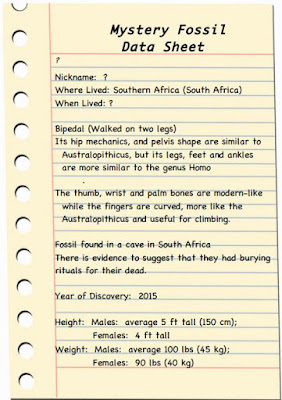Did you ever had that ONE lesson or that ONE activity in your classroom that clicks so well that you just want to shout it from the rooftops? Last week, for me, was one of those moments and I simply MUST SHARE!
I called it "YOU be the Archaeologist" and through some chance of enthusiasm, digital magic, inquiry based exploration or SOMETHING, my students spent a week exploring hominid fossils like PaleoAnthropologists. Their little noses were enthusiastically buried in details about Australopithicus, Homo habilis, Homo erectus, Neanderthal (and of course, Homo sapiens)....but it was SO MUCH MORE THAN THAT! They had a mission...a purpose...a puzzle to ponder. I'd opened a vault of inquiry.
It all centered around Homo Naledi...a National Geographic archaeological find that occurred within the past few years that has revolutionized our understanding of what it means to be human. To my students, Homo Naledi was introduced as mystery fossil, and all they knew was this:
The hook, of course, was digital...I gave them 3D models of fossils to evaluate. 3D models that are publicly available for anyone to use online (PC only) OR you can write Duke University for permission to download the 3D models for printing or for use on iPads (which I did, of course)!!!
Here's an example of the Homo naledi 3D Model:
 |
| On a PC, this model can zoom in, zoom out AND be rotated to any angle for viewing! |
Armed with the question, data sheets on each early hominid, and 3D Models of each hominid to explore, the students discussed their findings, and gathered their data together on their field notes.
Their discussions were compelling and their observations were incredibly detailed. Eleven year old students were considering physical traits of early hominid fossils and how those traits impacted the lives of those hominids. They were discussing skills and abilities of early hominids, such as ritualized burial ceremonies and how such a skill represented a more or less sophisticated species.
They discussed, evaluated, synthesized, compared...I could bury DOZENS of other Bloom words into the description, but the one most important to me was they were inspired!
They worked with determination, and to finalize their query, they had to make a decision. "Where on the evolutionary chart might this mystery fossil fit?" They used their evidence to support their decision. This was evidence based writing with a purpose.
After the big reveal of Homo naledi, we watched Lee Berger discuss the discovery of Homo naledi. We heard his passion as an explorer and we were inspired by the five incredible women who risked their lives crawling through the chamber to retrieve the fossils. Tom's talk ends with a call to future generations to prepare themselves to make discoveries and use technology to inform themselves. He continued with a message that can apply to ALL teachers at ALL levels, for it will be the hallmark of successful, engaged, critical thinking classrooms, and when he said the words, it gave me chills.
We need to inspire exploration.
and that's Using Your Smarticles





